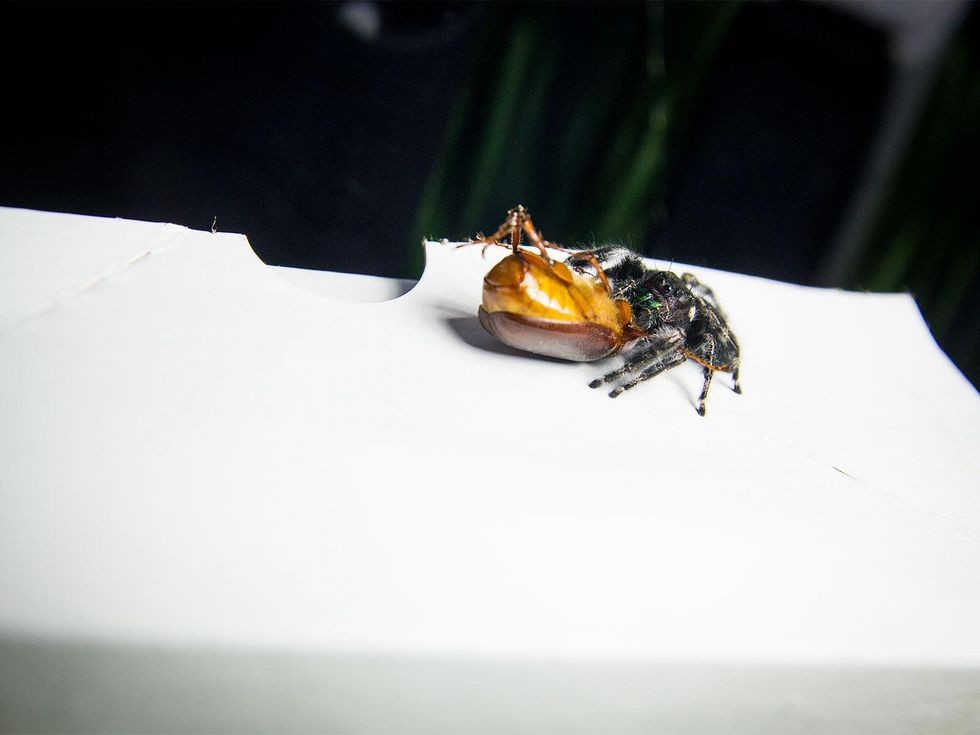The Farmer Diaries
Texas farmer finds hungry allies to combat army of June bugs
On a warm night under a bright moon in April, I set out to find my cat, Maggie, who was missing from the yard. Her mates from the same litter were already indoors for the night, but she was hiding in the tall grass. Sometimes she just doesn't want to be put up and will scamper away at the first hint of the sun dimming.
Finding a black cat at night can be a challenge, even when the moon is full. So I used a handheld spotlight, about as big as a car's headlight, to scan the field. The beam excited a huge population of scarab beetles, emerging from their larval stage underground and taking to the air.
Otherwise known as June bugs, these brown beetles are the size of a grape and fly toward light with the agility of a drunk frat boy. Everyone has seen them. They mark the unofficial beginning of spring, no matter what the date, careening into lighted garages and front porches at sundown, maybe catching themselves on clothing or a soft head of hair to ease their landing.
Cardinals not only eat seed, but they also eat June bugs. I could mark these beautiful birds down as pest control collaborators.
The bright light was a beacon for thousands of June bugs that night, and they all steered their flight path toward me and collided against me. It felt as if I were being pummeled, with some hitting me in the face, even my eyes, if not for my glasses.
In past years, I've seen plenty of June bugs, but this year's population was the largest I've ever experienced. After I found Maggie and returned to the house, the bugs rained down on every window, attracted by the indoor lights. They sounded like hail hitting the screen.
June bugs eat plants, so they are not a welcome sight to any farmer or gardener. They found their way into my greenhouse, drawn to the lights I used to keep basil growing optimally. I was growing the basil for a local restaurant and had made good progress. But now, June bugs were clustered on every plant, chewing half moon shapes into the leaves. So much for that crop.
Back inside, I started off the narration of my June bug encounter by asking my wife, Allee, "What eats June bugs?" I wasn't as much asking as I was making the point that whatever does eat June bugs will certainly do well this year. Still, that's only partial consolation for a ruined crop of basil and a few defoliated pepper plants that didn't make it through that night.
The next day, Allee put bird seed out in a feeder as she always does, and the cardinals gathered as they always do. But as she watched, a female cardinal flew to a cinder block a few feet away, holding a June bug in her beak. She thrashed it against the block and cracked it like an egg, then ate the soft meaty middle of the beetle before flying away.
It was a coincidental occurrence that answered my question from the night before. Apparently, cardinals not only eat seed, but they also eat June bugs. I could mark these beautiful birds down as pest control collaborators.
The first plan of action against any crop-eating insect is exclusion, so I screened in all the windows to the greenhouse to keep the June bugs out. The following evening, the results were immediate. Only a handful of beetles penetrated the barrier, not hundreds as the night before.
If each of the half dozen opossums on the farm eat as many beetles as the one I witnessed, every night amounts to a mass slaughter of June bugs.
Still, a handful can do their share of damage. In addition to basil, I grow squash, cucumbers, cilantro and lettuce in the greenhouse, as well as a few flowers. I started my next plan of action: remove them physically. I picked them off the leaves of my plants with my right hand and held them gently in my left; no reason to kill them if I can toss them out the door.
But as I picked up one June bug on top of a seed box on a shelf above my lettuce, something black hung off the back. It startled me, so I quickly let go. It was a little black jumping spider, who had made quite a catch for the night and was not about to lose it to some huge giant.
I looked at him for a while, took his photo and he looked back. After he had had enough of the novelty, he dragged his catch away. I added spiders to my growing list of June bug decimators.
The June bug population peaks and tapers off by mid-summer. But it being early spring, they were as numerous as ever. Being outdoors near any light was uncomfortable, as they bombarded anything in their way. Nevertheless, I had a few things to do outside one evening and suffered the annoyance.
As I sat on a picnic table near my illuminated greenhouse, witnessing the hailstorm of June bugs hitting the walls, something scurried below my feet. It was fast, large and made a loud noise in the grass as he vanished around the corner of the greenhouse.
I sat still, wanting to see if the little guy would return. From around the corner, I heard what sounded like someone crunching crushed ice with his mouth open. Each time, it was three or four crunches, a moment of silence. Three or four crunches, silence.
I trained my eyes on the corner where whatever it was had rushed by, hoping to see the cause of this crunching sound. Slowly bending around the corner and walking into view was an opossum.
There was glee in his expression as he ate one June bug after another from along the foundation of the greenhouse. As more beetles careened onto the walls and fell to the ground, he rushed to catch them with his long jaw line, perfect for such a task.
He ate for several minutes as I watched the beetles disappear steadily. More came and fell to the ground, but this little guy was on top of it, running back and forth along the wall. For the third entry on my list of pest control collaborators, I could mark down opossums.
Now I know why, on my nighttime treks outdoors, I've met up with one opossum or another around the house and near the greenhouse. It started with one or two, but then became one everywhere I went. They're gathering outside my windows to feast.
I also know why the June bug outbreak seems to have abated as of mid-April. If each of the half dozen opossums now residing on the farm eat as many beetles as the one I witnessed, every night amounts to a mass slaughter of June bugs. If there are more opossums in the field, as I suspect, then their assistance in the June bug decline is obvious.
Only a few of these beetles now beat against the windows at night. And my decimated pepper plants are showing signs of putting out new leaves. The basil may take longer to recover, but all other crops made it through unscathed.
Still in the beginning of the 2015 growing season, I feel relieved to know that my wildlife pest control force is working for me again. The birds, spiders and furry creatures that are attracted to the farm have much to contribute, just as several families of skunks did in 2013.
I look forward to the benefits brought by my new opossum crew. I expect beetles and squash bugs to stay at moderate numbers, and I know I'll likely not see a snake; opossums hate them and will not tolerate their presence. Additionally, new research on Lyme disease has shown that an area occupied by opossums will have as much as a 90 percent reduction in ticks as the marsupials are good at routing them out.




 Not everything at Green Pastures is fancy.Photo by Jessica Stephens
Not everything at Green Pastures is fancy.Photo by Jessica Stephens The guest rooms keep things simple and serene.Photo by Casey Dunn
The guest rooms keep things simple and serene.Photo by Casey Dunn The new addition looks nothing like the Victorian farmhouse it accompanies.Photo by Casey Dunn
The new addition looks nothing like the Victorian farmhouse it accompanies.Photo by Casey Dunn